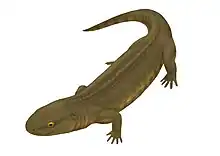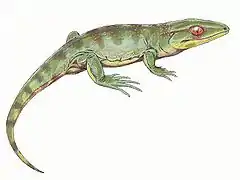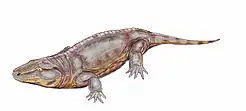| Ariekanerpeton Temporal range: Early Permian 284 Ma | |
|---|---|
 | |
| Scientific classification | |
| Domain: | Eukaryota |
| Kingdom: | Animalia |
| Phylum: | Chordata |
| Order: | †Seymouriamorpha |
| Family: | †Discosauriscidae |
| Genus: | †Ariekanerpeton Ivakhnenko, 1981 |
| Species | |
|
A. sigalovi Ivakhnenko, 1981 (type) | |
Ariekanerpeton is an extinct genus of seymouriamorph from the lower Permian. Fossils have been found from Tajikistan representing over 900 individuals of various stages of ontogenic development.[1] However, it is thought that none of these specimens are of fully mature animals as poor bone ossification is present and the neural arches are paired and disarticulated from the pleurocentra.[2]
Ariekanerpeton is thought to have been more closely related to Discosauriscus and Seymouria than to Utegenia due to the absence of gastralia or a postorbital-supratemporal contact. However, it is not a member of the family Discosauriscidae or the family Seymouriidae. There are no dermal scales present on post-metamorphic specimens as there are on Discosauriscus.[3] Lateral lines are present in the skulls of larval individuals but are lost soon after metamorphosis. Unlike Utegenia and Discosauriscus, Ariekanerpeton is thought to have inhabited relatively arid environments.[4]
References
- ↑ Ivakhnenko, M. F. (1981). Discosauriscidae from the Permian of Tadzhikistan. Paleontological Journal 1:114–128.
- ↑ "Ariekanerpeton sigalovi".
- ↑ Laurin, Michel (1996). "A reevaluation of Ariekanerpeton, a Lower Permian seymouriamorph (Vertebrata: Seymouriamorpha) from Tadzhikistan". Journal of Vertebrate Paleontology. 16 (4): 653–665. doi:10.1080/02724634.1996.10011355.
- ↑ Malakhov, D. M. (200). The topography of the lateral line organs on the skull of Utegenia shpinari. Biota 1(2):21-26.
- The Age of Dinosaurs in Russia and Mongolia by Michael J. Benton, Mikhail A. Shishkin, David M. Unwin, and Evgenii N. Kurochkin
- Chinese Fossil Vertebrates by Spencer G. Lucas
- Amniote Origins: Completing the Transition to Land by Stuart Sumida and Karen L.M Martin





